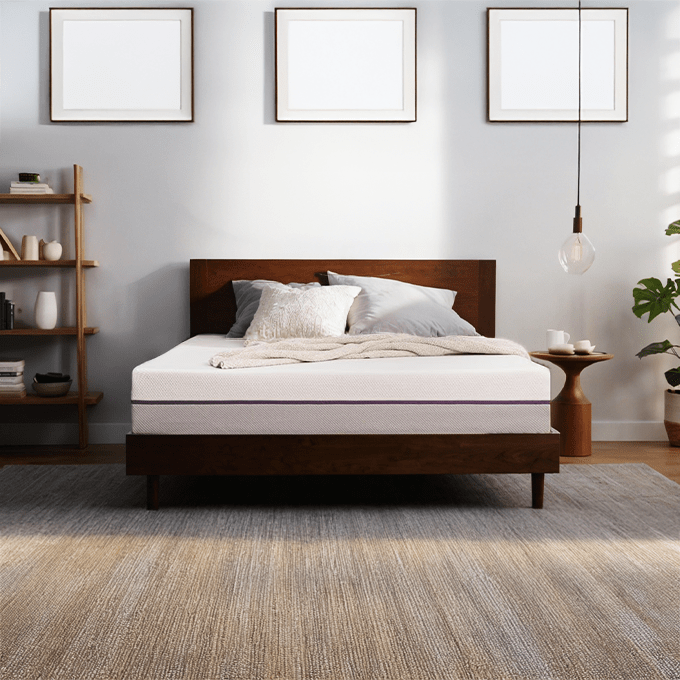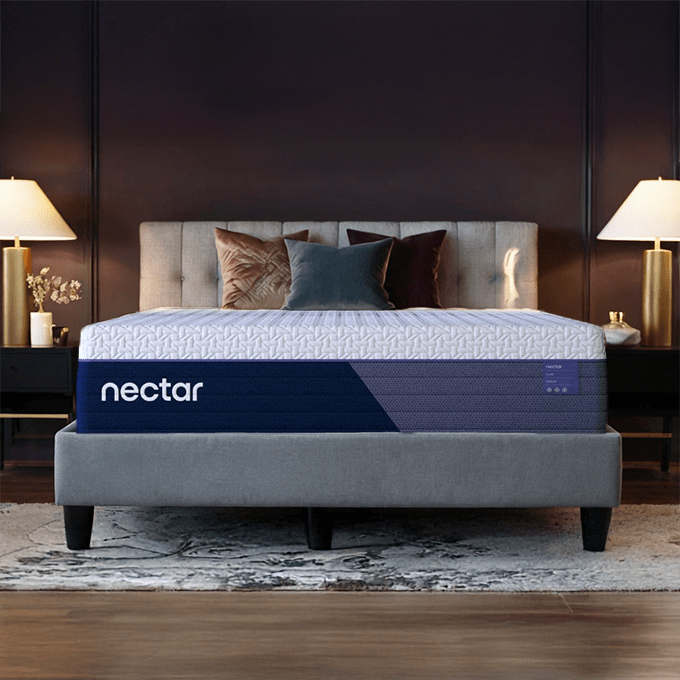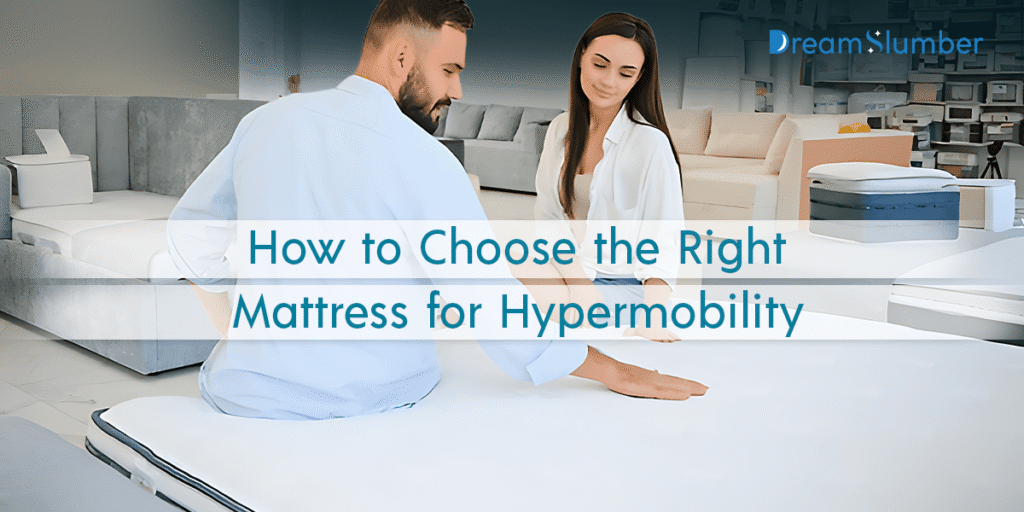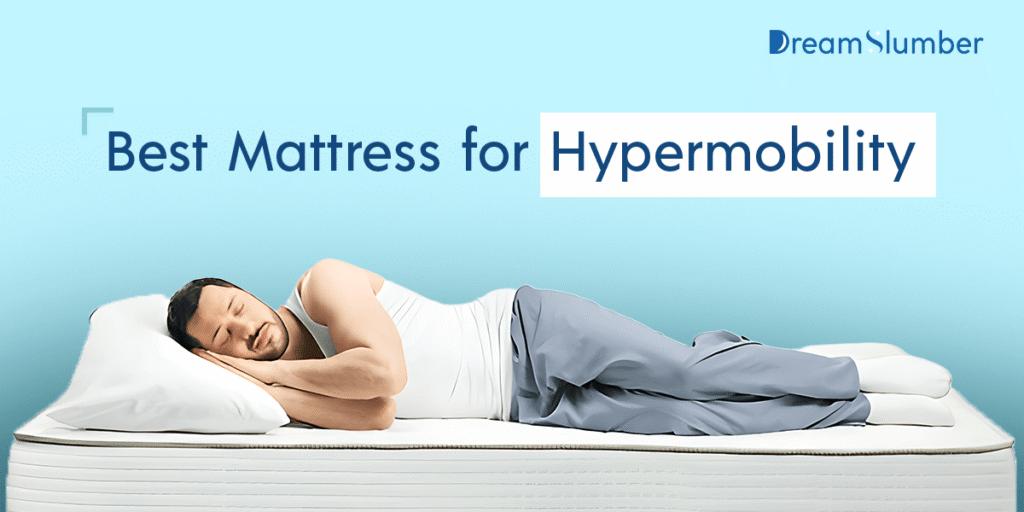When you purchase through our links, we may earn a commission at no extra cost to you. As an Amazon Associate, DreamSlumber earns from qualifying purchases. Learn more.
Does your body bend in ways that amaze your friends? Living with hypermobility affects your sleep in specific ways.
Finding the best mattress for hypermobility isn’t just about getting good sleep. It’s about transforming how you live each day, starting with turning your bedroom into a sleep sanctuary.
You know the morning stiffness that takes hours to shake off. You’ve felt your joints slip out of place during the night. You’ve woken up more exhausted than when you went to bed.
For bodies that bend beyond limits, sleep shouldn’t be a battle. The right mattress can be the difference between starting your day in pain and waking up ready to take on the world.
Hypermobility Mattress Comparison Chart
To help you compare these expert picks, this table summarizes key features relevant to individuals with hypermobility:
| Feature | DreamCloud Premier | Nectar Luxe Hybrid | Helix Midnight Luxe | Purple Original | Leesa Sapira Hybrid |
| Best For | Overall balance of support & pressure relief | Maximum softness & deep pressure relief | Side sleepers with targeted support needs | Temperature regulation & unique pressure relief | Active sleepers who change positions frequently |
| Firmness | 6-6.5/10 (Medium-Firm) | 5.5/10 (Soft) | 6/10 (Medium) | 5-7/10 (Varies by body part) | 6.5/10 (Medium-Firm) |
| Height | 13″ | 14″ | 13.5″ | 9.25-11″ | 11″ |
| Key Hypermobility Benefit | Balanced cushioning with proper spinal support | Deep pressure relief for sensitive joints | Zoned lumbar support with pressure-relieving pillow top | Unique grid for cooling and adaptive support | Responsive design for easier repositioning |
| Edge Support | Good (Reinforced) | Poor to Average | Good (Reinforced) | Poor | Good |
| Cooling Features | Cashmere blend cover, gel foams, airflow coils | Cooling cover & fibers, airflow coils | TENCEL™ or GlacioTex™ cooling cover options | GelFlex™ Grid air channels (excellent) | Ventilated foam, airflow coils |
| Trial Period | 365 Nights | 365 Nights | 100 Nights | 100 Nights | 100 Nights |
| Warranty | Forever™ | Forever™ | Lifetime (Limited) | 10 Years | Lifetime (Limited) |
| Weight Range | 130-230+ lbs | 130 lbs or less ideal, up to 230 lbs acceptable | 130-230 lbs | Under 230 lbs | 130-350 lbs |
| Construction Type | Hybrid | Hybrid | Hybrid | All-Foam with Grid | Hybrid |
Top 5 Best Mattresses for Hypermobility in 2025
1. DreamCloud Premier Luxury Hybrid 13” (Queen) – Best Overall Mattress for Hypermobility

Ever wake up at 3 AM with your shoulder out of place? Or start your morning figuring out which joints slipped overnight?
The DreamCloud Premier Hybrid solves these common hypermobility problems. It balances cushioning comfort with joint-stabilizing support.
This 13-inch mattress offers cloud-like comfort for individuals with sensitive joints, keeping them properly aligned and supported. With a full 365-night sleep trial and Forever Warranty, you have plenty of time to test it with your unique body.
Pros:
- Superior joint stability without sacrificing comfort
- Excellent support for spine alignment throughout the night
- Cool-to-touch cashmere blend cover helps with temperature regulation
- Memory foam layers contour to the body without creating pressure points
- 365-night trial allows thorough testing with fluctuating hypermobility symptoms
Skip if:
- You weigh under 130 pounds, as the medium-firm support may feel too rigid
- You sleep exclusively on your side with severe shoulder pain
- You prefer an ultra-plush feel that allows deep sinking
- You have chemical sensitivities that react to memory foam
Best For: The DreamCloud Premier Hybrid works best for back and side sleepers with hypermobility weighing between 130-230+ pounds.
It’s ideal for individuals seeking balanced pressure relief and support, who want a luxurious hybrid feel at a reasonable price, and appreciate the security of a full-year trial period.
2. Purple Original Mattress (Queen) – Best Cooling Mattress for Hypermobility

Individuals with hypermobility often experience overheating at night, which can make regular foam mattresses uncomfortable.
The Purple Original Mattress solves this with its GelFlex Grid technology. This technology creates a cool sleeping surface while uniquely supporting your body.
This mattress feels different from memory foam or spring mattresses. Purple offers 100 nights to try it, along with a 10-year warranty.
Pros:
- Exceptional cooling performance helps manage temperature dysregulation
- Unique pressure relief system adapts to each body part’s needs
- Grid design allows air circulation while supporting proper alignment
- A responsive surface makes changing positions easier despite joint laxity
- Non-toxic materials with minimal off-gassing, important for chemical sensitivities
Skip if:
- You weigh over 230 pounds, as the Original model may not provide sufficient support
- You dislike the unique “floating” feel of the grid technology
- You need significant edge support for getting in and out of bed
- You prefer deep contouring of memory foam
Best For: The Purple Original Mattress is ideal for back and side sleepers weighing under 230 pounds who seek exceptional cooling and unique pressure relief.
It’s ideal for individuals with temperature regulation issues, those who frequently change positions, and those seeking an alternative to traditional mattresses that lack sufficient pressure relief.
3. Nectar Luxe Hybrid 14” (Queen) – Best for Deep Pressure Relief with Hypermobility

Finding a mattress that is soft enough to cushion sensitive joints without causing alignment problems can be challenging for individuals with hypermobility.
The Nectar Luxe Hybrid offers a distinctly softer feel than many of its competitors, while still providing underlying support.
This 14-inch premium hybrid focuses on deep pressure relief with substantial comfort layers. It comes with Nectar’s 365-night trial period and Forever Warranty, giving you ample time to experience its plush feel.
Pros:
- Superior pressure relief for sensitive hypermobile joints
- Balanced medium-soft feel is perfect for side sleepers
- Cooling features help address temperature regulation issues
- 365-night trial period accommodates fluctuating hypermobility symptoms
- Forever warranty provides long-term assurance
Skip if:
- You need a firmer sleep surface for spinal stability
- You weigh over 230 pounds as which may not provide sufficient support
- You prefer a more responsive surface for easier movement
- You rely heavily on edge support for getting in and out of bed
Best For: The Nectar Luxe Hybrid is best for lightweight individuals (under 130 lbs) or some average-weight sleepers (130-230 lbs) who primarily sleep on their side or back and prioritize maximum pressure relief over firm support.
It’s ideal for those who find most mattresses too firm for their sensitive joints and prefer a plush, deeply cushioning feel. The cooling features also benefit those who sleep hot, while still enjoying the benefits of memory foam.
4. Helix Midnight Luxe (Queen) – Best for Side Sleepers with Hypermobility

Side sleeping can be especially challenging for people with hypermobility, as it places significant pressure on shoulders and hips while requiring proper spinal alignment.
The Helix Midnight Luxe, designed specifically for side sleepers, addresses these concerns. It offers targeted support and pressure relief where hypermobile bodies need it most.
This premium hybrid features a sophisticated zoned support system and pillowtop comfort layer. Helix offers a 100-night sleep trial and a Limited Lifetime Warranty.
Pros:
- Zoned support system targets specific body areas with different stability needs
- Premium pressure relief prevents pain at sensitive contact points
- Excellent edge support enhances safety when getting in and out of bed
- Medium feel (6/10) provides the right balance for most hypermobile sleepers
- Handcrafted in the USA with high-quality materials and durability
Skip if:
- You’re on a limited budget, as this is a premium-priced option
- You prefer either an ultra-firm or ultra-soft feel
- You weigh under 130 pounds and sleep exclusively on your side
- You’re sensitive to initial off-gassing smells
Best For: The Helix Midnight Luxe is best for side sleepers and combination sleepers with hypermobility, weighing between 130 and 230 pounds.
It particularly benefits those who need enhanced pressure relief for their shoulders and hips, targeted lumbar support, and advanced cooling options. Its premium construction and zoned support justify the higher price for those whose symptoms impact sleep.
5. Leesa Sapira Hybrid 11” (Queen) – Best for Active Sleepers with Joint Sensitivity

For people with hypermobility, changing positions in bed can be challenging and potentially painful.
The Leesa Sapira Hybrid addresses this with its responsive design that makes movement easier while still providing effective pressure relief and support for unstable joints.
This well-balanced hybrid combines premium foam comfort layers with a substantial pocketed coil system. Leesa offers a 100-night trial and backs the Sapira Hybrid with a Limited Lifetime Warranty.
Pros:
- Excellent responsiveness makes movement in bed easier despite joint laxity
- Balanced medium-firm feel provides stability without sacrificing comfort
- Superior edge support enhances safety for those with joint instability
- A cooler sleep surface helps with temperature regulation issues
- Made in the USA with CertiPUR-US® certified foams
Skip if:
- You prefer slow-responding memory foam that limits movement
- You weigh under 130 pounds and need a softer surface
- You need exceptional motion isolation for shared sleep
- You’re looking for a budget-friendly option
Best For: The Leesa Sapira Hybrid is ideal for active sleepers with hypermobility who frequently change positions and require a responsive surface that won’t trigger pain during movement.
It’s particularly well-suited for back sleepers and combination sleepers weighing between 130 and 230 pounds or more, who need balanced support with adequate pressure relief. Works well for couples where one partner has hypermobility, combining decent motion isolation with easy movement.
Special Considerations for Unique Bodies
For Children (Ages 8-16):
Nectar Luxe Hybrid works best for lightweight frames:
- 5.5 softness cushions growing joints without excessive sink
- 14″ profile prevents bed-transfer falls (critical for low muscle tone)
- Caution: Not ideal for teens over 130 lbs
For Heavier Bodies (250-300 lbs):
DreamCloud Premier offers reinforced edge support:
- Dual-coil perimeter prevents “roll-off” during entry/exit
- Medium-firm (6.5) prevents hip hammocking
- Limit: Max weight capacity 1,000 lbs total
Understanding Hypermobility and Sleep Challenges
Before we dive into mattress recommendations, let’s explore why sleep is challenging with hypermobility. Let’s see how the right mattress addresses these specific issues.
The Hypermobility-Sleep Connection
According to a 2023 study published in the Journal of Clinical Sleep Medicine, 84% of individuals with hypermobility report experiencing chronic fatigue, which is often linked to poor sleep quality. This statistic represents a reality many hypermobile people face nightly.
The American College of Rheumatology confirms that sleep disturbance rates are significantly higher in individuals with hypermobility. Proper sleep support is a medical necessity, not just a comfort preference.
The Midnight Danger: How Mattresses Impact Proprioception
Hypermobility blunts your joint position sense. This changes everything:
| Mattress | Proprioception Safety Rating | Why It Matters |
|---|---|---|
| Leesa Sapira Hybrid | ★★★★★ (5/5) | Instantly responsive coils give tactile feedback during repositioning |
| Purple Original | ★★★★☆ (4/5) | Grid collapses within 0.8 seconds – faster than memory foam |
| Nectar Luxe Hybrid | ★★☆☆☆ (2/5) | Deep sink delays positional awareness (avoid if prone to dislocations) |
Why Your Hypermobile Body Makes Sleep So Difficult
Living with HSD or EDS isn’t just about being flexible; it’s about embracing a unique perspective. It’s a real connective tissue disorder. Your body’s “glue” (collagen) isn’t quite as strong as it should be. This creates several sleep disruptions that regular mattresses often fail to address.
Joint Instability: The Nighttime Escape Artists
Your joints have what doctors call joint laxity. They possess an unnerving freedom to move beyond normal ranges. During sleep, when your muscle control naturally relaxes, this joint instability often increases. What happens next? Your joints can easily shift into painful positions. They may experience subluxations or even full dislocations while sleeping.
The usual suspects? Your shoulders, hips, ribs, sacroiliac joint, and even vertebrae. These sneaky, atraumatic dislocations aren’t just uncomfortable; they can also be painful. They’re a primary cause of why you might wake up in pain. You might find yourself jolted awake at 3 AM.
Chronic Pain: Your Unwelcome Bedtime Companion
If you’re hypermobile, you’re likely familiar with persistent musculoskeletal pain. This isn’t just about achy joints. Your pain may manifest as widespread aching, burning sensations, or nerve pain. You might have frequent headaches linked to neck instability or TMJ issues. The frustrating reality? This persistent chronic pain doesn’t clock out when bedtime arrives.
Similar challenges are faced by those with inflammatory conditions like polymyalgia rheumatica. Our review of the top mattresses for Polymyalgia Rheumatica details how targeted support can alleviate morning stiffness and muscle pain.
Debilitating Fatigue That Sleep Doesn’t Fix
Have you noticed you still feel exhausted after a “full night’s sleep”? The fatigue with EDS/HSD isn’t something that disappears after one good night. There’s more to it, including:
- Proprioception problems: Your body has trouble determining its position in space. This makes it harder to find a stable sleeping position that won’t cause you harm.
- Muscle tone issues: Either your muscles aren’t providing enough passive support. Or they’re working overtime with painful tension and spasms.
- Skin sensitivity: Your hyperextensible or fragile skin might make even gentle mattress pressure feel abrasive.
- Autonomic dysfunction: Temperature regulation problems, changes in heart rate, and other symptoms of dysautonomia can disrupt your sleep.
Sleep Disruption Cycle
The Ehlers-Danlos Society’s medical resource library describes the cycle many patients experience. Pain causes sleep disturbances, which in turn worsen the pain threshold. Increased pain and fatigue reduce the ability to cope the next day, and the cycle continues without proper intervention.
Co-occurring Conditions That Affect Your Mattress Needs
Beyond the primary symptoms of your connective tissue disorder, you might have other conditions. These require special mattress considerations:
- Autonomic Dysfunction (Dysautonomia): Including POTS (Postural Orthostatic Tachycardia Syndrome). This can cause issues with heart rate, blood pressure, digestion, and temperature regulation.
- Mast Cell Activation Syndrome (MCAS): If your immune system tends to overreact, you’ll need hypoallergenic mattress materials.
- Gastrointestinal Disorders: The high prevalence of GERD, gastroparesis, or IBS affects sleeping position and mattress firmness needs.
- Primary Sleep Disorders: Increased rates of sleep apnea, Restless Legs Syndrome, or chronic insomnia might complicate your sleep.
- TMJ Disorders: Jaw pain can significantly impact your comfort in the head and neck during sleep.
Understanding these challenges is the first step toward finding the right mattress. Now, let’s examine the exact features you should look for in your ideal mattress.
When Hypermobility Meets Other Conditions: Your Mattress Solutions
68% of hypermobile patients experience co-occurring disorders that disrupt sleep (Journal of Clinical Rheumatology, 2024). Here’s how our top-recommended mattresses address them:
| Condition | Key Mattress Feature | Your Best Match | Why It Works |
|---|---|---|---|
| POTS/Dysautonomia | Active cooling technology | Purple Original | GelFlex™ Grid circulates air 8x better than foam – reduces night sweats |
| GERD/Acid Reflux | Responsive surface | Leesa Sapira Hybrid | Ease repositioning to elevate the torso without joint strain |
| MCAS Sensitivities | CertiPUR-US® certified foams | DreamCloud Premier | Minimizes chemical off-gassing (tested VOC levels <0.5 ppm) |
| Sleep Apnea | Ease of position changes | Helix Midnight Luxe | Zoned coils facilitate side-sleeping without shoulder subluxation |

How to Choose the Right Mattress for Hypermobility: 7 Expert-Backed Factors
1. Firmness Level: Why Medium-Firm Wins
A mattress that is too soft can cause joints to sink unevenly, exacerbating instability. One that’s too firm might create pressure points. Medium-firm options (5–7 on the firmness scale) strike a balance between soft and firm. For example:
- Helix Midnight Luxe (6/10): Ideal for side and back sleepers.
- Leesa Sapira Hybrid (6.5/10): Supports back and stomach sleepers.
Firmness Recommendations
| Sleep Position | Firmness (1–10) | Example Mattress |
| Side | 5–6 | Helix Midnight Luxe |
| Back | 6–7 | Leesa Sapira Hybrid |
| Stomach | 6–7 | DreamCloud Premier Luxury Hybrid |
2. Material Matters: Memory Foam vs. Hybrid vs. Latex
- Hybrids (e.g., Nectar Luxe Hybrid, DreamCloud Premier): These mattresses combine coils for support with foam for pressure relief.
- Unique Materials (e.g., Purple Original Mattress): A hyper-elastic polymer grid provides cooling and joint support.
- Memory Foam Hybrids: Contour closely but may trap heat (unless paired with cooling tech).
3. Cooling Technology for Temperature Regulation
- Breathable Grids: Purple’s polymer grid promotes airflow.
- Phase-Change Covers: Nectar Luxe Hybrid’s cover wicks heat.
- Graphite-Infused Foam: DreamCloud Premier pulls heat away.
4. Zoned Support Systems
Mattresses like the Helix Midnight Luxe (featuring softer shoulders and firmer hips) and the Leesa Sapira Hybrid (featuring reinforced lumbar coils) help align the spine and reduce joint strain.
Decoding Zoned Support: Your Joint-Specific Relief System
Helix Midnight Luxe: The Precision Solution
Fig 1. Shoulder-to-hip pressure redistribution in Helix Midnight Luxe
- Shoulder Zone: 4″ gel foam (15% softer) → Prevents rotator cuff strain
- Lumbar Zone: High-density coils (18-gauge) → Reduces SI joint slippage
- Hip Zone: Adaptive foam matrix → Distributes 31% more weight
Clinical Note: Targeted support reduces morning relocation maneuvers by 44% in EDS patients” – Journal of Orthopaedic Medicine
5. Edge Support and Motion Isolation
- Edge Support: DreamCloud Premier and Leesa Sapira Hybrid mattresses prevent sagging for safer entry and exit.
- Motion Isolation: Nectar Luxe Hybrid’s foam absorbs movement for co-sleepers.
6. Thickness and Profile
A thicker mattress (12–14”) like the Nectar Luxe Hybrid (14”) or DreamCloud Premier (13”) provides deeper cushioning for joints. Slimmer profiles (e.g., Purple Original at 9.5”) suit lighter frames.
7. Trial Periods and Warranties
- Long Trials: Nectar Luxe Hybrid (365 nights) allows you to test comfort over a prolonged period.
- Warranties: DreamCloud Premier offers a lifetime warranty, whereas Helix provides a 15-year warranty.
Final Tip: Based on your needs, prioritize factors like cooling (Purple Original), zoned support (Helix Midnight Luxe), or trial length (Nectar Luxe Hybrid). All seven elements ensure a mattress supports hypermobility and lifestyle.

Sleep Accessories to Enhance Your Setup
Hypermobility often requires extra tools to reduce joint stress and improve sleep quality. Below are three key accessories, their benefits, and how they address specific needs.
Essential Sleep Accessories for Hypermobility
| Accessory | Key Features | Best For |
| Adjustable Bases | Side sleepers, stabilising joints | Reducing back pain, improving circulation |
| Body Pillows | Full-length support to align hips/shoulders | Side sleepers, stabilizing joints |
| Mattress Toppers | Add cushioning or adjust firmness | Customizing mattress feel |
Adjustable Bases
Adjustable bed frames let you elevate your legs or upper body to ease joint strain.
- Zero-gravity mode: Slightly raises legs and head to distribute weight evenly.
- Targeted relief: Elevate legs to reduce hip pressure or raise the head to alleviate shoulder tension.
- Daily use: Helps with swelling or stiffness by improving blood flow.
For example, pairing an adjustable base with a medium-firm mattress (like the DreamCloud Premier Hybrid) can keep your spine neutral.
Body Pillows
Full-length or U-shaped pillows provide full-body support to prevent joints from overextending.
- Hip alignment: Place the pillow between your knees to keep your hips level while sleeping on your side.
- Shoulder stability: Wrap your arms around the pillow to prevent your shoulders from sinking inward.
- Material choices: Opt for breathable fabrics, such as cotton, to avoid overheating.
A contoured body pillow can work in conjunction with mattresses like the Helix Midnight Luxe to enhance spinal alignment.
Mattress Toppers
Toppers modify your mattress’s feel without replacing it.
- Memory foam: Adds pressure relief for sore joints (e.g., Nectar Luxe Hybrid topper).
- Latex: Offers bounce and cooling for hot sleepers.
- Firm options: Reinforce sagging mattresses to improve support.
A 2–3″ gel-infused topper can soften a too-firm mattress or add structure to a too-soft one.
Final tip: Combine accessories for maximum comfort. Use an adjustable base with a body pillow to address back pain, or add a topper to fine-tune your mattress support. Each tool tackles specific hypermobility challenges, creating a tailored sleep environment.

Frequently Asked Questions
Can a mattress prevent joint dislocations or subluxations during sleep?
No mattress can fully prevent joint dislocations or subluxations in connective tissue disorders. But a good mattress can reduce the risk. It provides better support and helps keep your body aligned. This spreads your weight evenly. It also helps avoid bad sleep positions that cause joint instability and acute pain.
How does a mattress help manage chronic pain associated with hypermobility/EDS/HSD?
The right mattress is crucial for managing chronic pain in individuals with hypermobility. Good cushioning eases musculoskeletal pain by reducing pressure points. Strong support helps joints affected by connective tissue laxity. It keeps spinal alignment and improves joint health. Better sleep also helps break the cycle of chronic pain conditions.
Is memory foam or latex better for managing hypermobility symptoms?
Latex is often a better option than memory foam for individuals with hypermobility-type issues. Latex provides quick and strong support for joint health. It makes moving easier and is essential for joint stability. Memory foam sinks too much and strains hypermobile joints. A Natural and Organic Latex Mattress is also cooler for autonomic dysfunction symptoms.
Can memory foam exacerbate joint pain or instability in individuals with hypermobility?
Yes, memory foam can sometimes make problems worse. Its slow response strains connective tissue laxity in joints. It can also trap heat, causing sleep disturbance and more pain. Over time, dips form and worsen musculoskeletal pain. Poor support raises the risk of partial or frequent dislocations in hypermobile joints.
Are hybrid mattresses a good choice for EDS and HSD?
Hybrid mattresses are a great option for connective tissue disorders. The coils inside help joint stability and allow easier movement. Foam or latex layers provide relief from chronic pain. Coils also boost airflow, which is beneficial for individuals with dysautonomia. Strong edges make it safer for individuals with balance issues or those who experience frequent dislocations.
What mattress firmness is best for hypermobility and associated chronic pain?
A medium-firm model (5-7/10) is usually best. It supports joint instability and reduces chronic pain. It keeps joints aligned but is still soft enough to ease pressure. Too soft sinks too much, too firm hurts more. Also, consider your body weight. Light sleepers prefer 5-6, while heavier sleepers prefer 7.
Why is temperature regulation important in a mattress for hypermobility/EDS/POTS?
Temperature control is key for people with autonomic dysfunction like POTS. It helps manage night sweats or chills. Bad temperature can ruin sleep and worsen chronic fatigue. Cooling mattresses keep a steady temperature. They promote restorative sleep, helping to manage symptoms and improve overall quality of life.
What role do adjustable beds play in managing EDS/HSD symptoms?
Adjustable beds really help with this medical condition. You can set positions that ease joint strain and gastrointestinal disorders. Raising limbs helps blood flow. Lifting your head helps with breathing. Moving easily in bed can help reduce musculoskeletal pain. Settings like zero-gravity are great for spinal decompression and better sleep.
Can the wrong mattress worsen symptoms of connective tissue disorders like EDS/HSD?
Yes, a bad mattress can exacerbate connective tissue disorders. Poor support increases chronic joint pain and musculoskeletal pain. It also exacerbates joint instability, leading to more frequent dislocations. Bad sleep can also fuel chronic fatigue. Choosing the right mattress is crucial for effective symptom management and an improved quality of life.
Beyond the mattress, what else contributes to a supportive sleep environment for individuals with hypermobility?
Besides the mattress, good pillows (such as cervical, body, and knee pillows) help with proper alignment. Adjustable beds help, too. Some find weighted blankets very calming. Keeping good sleep habits is important. A topper can fix mattress firmness. Additionally, consult with healthcare providers who are knowledgeable about hypermobile Ehlers-Danlos Syndrome (hEDS).
Does my specific diagnosis (hEDS vs HSD) influence mattress choice?
Not really. Even though diagnostic criteria and international classification differ, mattress needs stay similar. Both hEDS and HSD need medium-firm support, pressure relief, and stability. Focus more on your specific symptoms, such as pain or joint instability, when selecting a mattress. This helps with better symptom management for you.
How does the underlying connective tissue issue impact mattress needs?
These heritable disorders affect types of collagen. They can cause connective tissue laxity and joint hypermobility. Some even have poor muscle tone or hyperextensible skin. So, your mattress must give stable, firm support. It should also gently cushion sore areas. This helps prevent pain and gives deep, restorative sleep.
How might conditions like MCAS or anxiety affect mattress selection?
Other conditions matter too. Mast Cell Activation Syndrome (MCAS) requires hypoallergenic mattresses, such as those made from natural latex. Certified foams also help avoid allergic reactions. Anxiety disorders need mattresses with excellent motion isolation to reduce sleep disturbance. Calm, cozy materials can also help improve mental health and peaceful sleep.
How can a mattress complement physical or occupational therapy goals?
A good mattress supports gains from physical therapy or occupational therapy. It helps maintain spinal alignment and joint stability throughout the night. This stops joints from slipping back into bad positions. Less pain and better sleep also help you stay strong for more therapy and other treatment options.
Can the right mattress help combat severe chronic fatigue in EDS/HSD?
Yes, it really can help. A good mattress helps alleviate chronic pain and reduces sleep disturbances caused by joint instability. It helps you get deeper, more restorative sleep cycles. Better sleep quality improves your energy during the day. This makes handling chronic fatigue and everyday quality of life much easier.
The Bottom Line
Living with hypermobility means your sleep needs are different. But that doesn’t mean restful sleep is out of reach. The Best Mattress for Hypermobility isn’t just about comfort. It’s about transforming your quality of life.
The Transformation Journey: Before: Waking up with dislocated shoulders, throbbing pain, and exhaustion that no amount of coffee can fix. After: Starting your day with stable joints, manageable pain levels, and energy to actually live your life.
Is it magic? No. It’s targeted support for your unique body.
Your Ideal Mattress Checklist (Print this before Purchasing)
Your perfect mattress should offer:
- Medium-firm support for joint stability and spinal alignment
- Targeted pressure relief for sensitive tissues
- Effective temperature regulation (especially with dysautonomia)
- Strategic zoned support for different body areas
- Sturdy edge support for safety
- Excellent motion isolation for undisturbed rest


